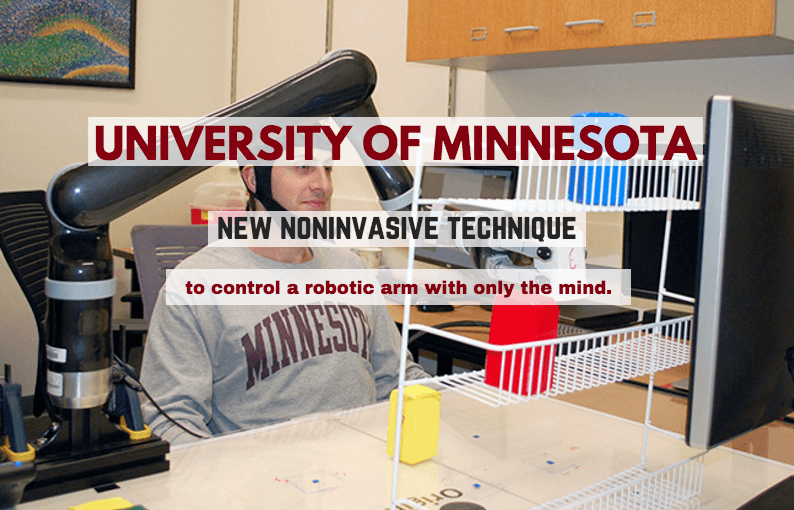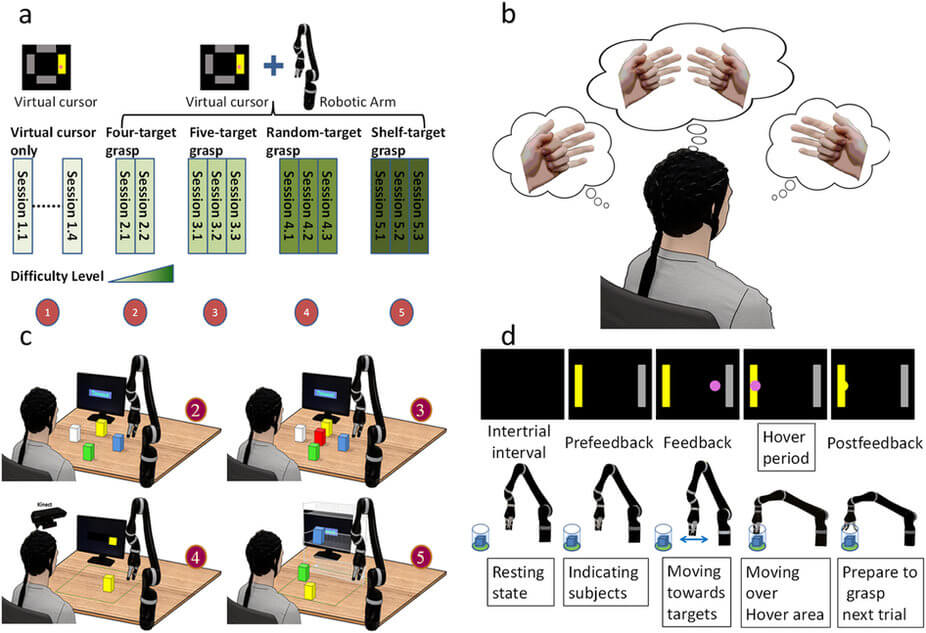Imagine you could move an object just by thinking about moving it – there you go. Just by thinking it, you are able to move it.
According to researchers at the University of Minnesota, people can now control a robotic arm using only their minds, without a brain implant.

How does it work?!
Via a technique called electroencephalography (EEG).
Subjects wear a noninvasive brain cap fitted with electrodes, and their “thoughts” are converted into action by “advanced signal processing and machine learning.”
The brain-computer interface technology works due to the geography of the motor cortex—the area of the cerebrum that governs movement. When humans move, or think about a movement, neurons in the motor cortex produce tiny electric currents. Thinking about a different movement activates a new assortment of neurons… Sorting out these assortments using advanced signal processing laid the groundwork for the brain-computer interface used by the University of Minnesota researchers.
Experiment & Success Rates
A series of experiments (8–15 sessions) were performed on a group of 13 healthy human subjects. Subjects were to control a robotic arm and perform complex reach-and-grasp tasks which progressively increased in difficulty. The task was divided into two stages:
- The subject was to guide the cursor/robotic arm within a two-dimensional (2D) plane to a region above a target object within 3D space and hover over it.
- If the subject selected the correct object s/he was then to guide the robotic arm down in the third dimension to grasp the object.
Subjects were able to pick up objects in fixed locations with high accuracy – an average success rate above 80 percent. They were able to move objects from one location to another (the table onto the shelf) with an average success rate above 70 percent.
This shows that with the EEG, we can willingly modulate brain activity to control a robotic arm with freedom within the span of only a few training sessions.
Implications
This invention and research has the potential to help the millions of people who are incapable or have little freedom to move their arms due to neuromuscular disorders/neurodegenerative diseases. This includes individuals who suffer from muscular dystrophy, brain stem stroke, and spinal cord injuries.
Done effectively, this noninvasive technique can bridge the gap not only between the brain and the outside world, but between the physically healthy and the paralyzed.
[divider]
Researchers:
- Bin He -UMN biomedical engineering professor, director of the UMN Institute for Engineering in Medicine & and lead researcher on the study
- Jianjun Meng – biomedical engineering postdoctoral researcher
- Bryan Baxter – biomedical engineering graduate student
- Angeliki Bekyo – Institute for Engineering in Medicine staff member
- Shuying Zhang – biomedical engineering undergraduate student
- Jaron Olsoe – biomedical engineering undergraduate student
Funders:
- National Science Foundation (NSF)
- National Center for Complementary and Integrative Health
- National Institute of Biomedical Imaging and Bioengineering
- National Institute of Neurological Disorders and Stroke of the National Institutes of Health (NIH)
- University of Minnesota’s MnDRIVE Initiative x Minnesota Legislature




